9 Fun, Nearly Zero-Prep Ways to Practice the Verb “To Be” with children
Photos and gifs: https://giphy.com/ and pixabay.com
Are you the type of teacher who is always looking for low or no-prep activities? Today, I have 9, almost non-prep activities for you
1. VERB TO BE STOP THE BUS GAME: Provide your learners with a sheet of paper and ask them to divide it in the following way:
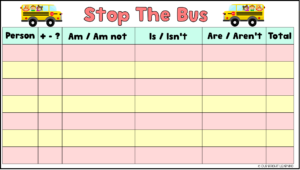
Then, group your students in teams of three or four. Ask them to write on small pieces of paper the following subjects: mom, dad, parents, 1 friend, 2 friends, my friends and I, artist, sportsperson, sister, brother, siblings, friends, 1 cousin, 2 cousins, grandparents, pet, animal, object, city, place, etc. (Feel free to adapt the subject to your students’ needs.)
Additionally, using 9 more small pieces of paper, ask them to write the following symbols: + (affirmative), – (negative), and ? (interrogative). After having all the words and symbols written on small pieces of paper, place them in two different boxes or plastic bags, mix them, and ask the children to take turns drawing one piece of paper from each container. As soon as the child picks the subject and symbol, they must read them aloud in order to start the game. When the students listen to the subject and the symbol, they must rapidly start writing a logical sentence under the correct verb to be form.
Example:
Player 1: (draws one piece of paper from each container) brother – negative
Everybody, including the competitor, must write a sentence under the correct column fast and correctly, as it is shown in the table below.
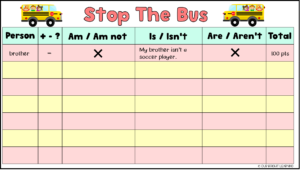
The player who finishes the sentence first must shout “STOP” and the rest of the players must stop writing immediately. Then, the team must check if the player’s sentence was correct or not. If it is correct, he/she gets 100 points; if the rest of the students’ sentences are correctly answered as well, they will get 50 points each, and all the incorrect answers get 0 points. After having checked all the sentences and points, another player will be chosen to draw the two pieces of paper. The team must continue playing until all the subjects have been drawn. Finally, the contestants must add up all their points; the child with the most points will be the winner.
2. ALL ABOUT ME PROJECT: This project is divided into two parts:
PART 1: First, allow the children to work on the “All About Me Craft.” Download the version that fits your groups better here for free.
After having finished the craft, you may ask the children to share their personal information with many of their classmates in order to ensure the necessary repetition to internalize these basic questions. You can also request them to make circles, one inside the other. The students in the outer circle will dance around the students in the inner circle, as they all listen to some fun music. When you stop the music, each child must be facing a different classmate, and the exchange of information will start in the following way:
Example: (Every single child must be holding their “All About Me Craft” in their hands so that they can show it to their different classmates.) Then, they will show their craft and say the following:
Hi, my name is _________________.
I’m ____ years old.
My favorite sport is _________.
My favorite toy is ___________.
My favorite animal is __________.
My favorite movie is _________.
My eyes are ___________ etc., etc.
PART 2: After having shared the information created on their “All About Me Craft” with at least three students, ask some learners to retell the information about one of their classmates in the following way:
She is Mariana.
Mariana is 8 years old.
Mariana’s favorite sport is ________.
Mariana’s favorite toy is ________.
Mariana’s favorite animal is _________ etc., etc.
You may complement these amazing crafts with the following Boom Cards deck. This deck may also be useful when working with slower learners or students with special needs. Download this FREE PACK FOR FREE!
Video Player
00:00
00:00
3. GUESSING THE CHARACTER: For this activity, ask the students to take turns coming up to the front of the classroom. Ask each participant to avoid looking at the whiteboard and ask them to face their classmates instead. Immediately write the name of a famous character they know about on the white board. The rest of the class must provide that student with clues/sentences
Example:
CLASSMATE 1: You are a singer.
CLASSMATE 2: Your eyes are black.
CLASSMATE 3: Your hair is blonde.
CLASSMATE 4: You are Colombian.
PLAYER: I am Shakira!
TEACHER AND CLASSMATES: Correct!
If the player guesses the word, their group will receive a point. The group with the most correct answers will be the winner.
4. RUN AND WRITE: Print or write the verb to be forms is – are – am – isn’t – aren’t – am not on big pieces of paper. Place them in a plastic bag or any other container. Then, divide your class into teams, ask each team to choose a representative, and give a marker to each representative. As soon as the representatives are ready to play, you must draw a piece of paper from the container and read it aloud. All the contestants must run towards the whiteboard and write a logical sentence using the word given. The group that completes the task correctly and the fastest will get the point. The winning group will be the one that gets the most points.
Variation: This game can be adapted to meet the needs of more basic or more advanced students by adding extra information to the verb forms.
Example:
You can write isn’t – Lucas – at school in order to support your students and prompt them more.
5. FIX MY SPEECH: Prepare a list of incorrect sentences in advance. The sentences must be designed based on vocabulary you have studied before with the group and include the verb to be). Divide the class into teams. Start playing with two teams and ask them to send a representative to the front. Request that the two competitors stand facing each other, and place an object (a toy, a marker, etc.) between the two players, positioned at equidistant points. Explain to them that they will listen to an incorrect sentence, identify the mistake, and rapidly grab the object that has been placed in the middle of them. The student who takes the object first will have the right to point out the error they found. After stating it, the other player will have the right to suggest what they think the error might be. After, the teacher will say who was right and will give the point to the group that deserves it. The winning group will be the one that gets the most points.
6. DRAWING/PHOTO TALKING: Invite your kiddos to draw a picture of their family or friends. If they can, ask them to bring a photo that has them and their loved ones in it. Then, persuade them to talk about their picture/photograph by talking about your own, using the verb to be.
Example:
She is my mom.
She is a doctor.
She is 38 old.
She is intelligent, pretty, and sweet.
I am _______,
I am happy.
I’m 8 years old.
I’m a student.
I’m a good friend.
I’m good at soccer, math, etc., etc.
For more practice, you can ask them to talk about their best friend’s photographs too.
7. A SONG: Besides the traditional exercises we usually do in class with songs, you can also challenge your learners to simply listen, grasp the sentences, and write them down. Later on, you might ask your students to create a “play” or type of “drama” according to the lyrics of the song. Provide them with clothes, hats, accessories, and makeup to make it much more appealing. This exercise might be done in pairs or trios.
Variation: Ask the student to adapt the music and rhythm of the song to their own lyrics. They might include their names, previously studied vocabulary, and obviously, the verb to be.
The following are some songs you could use with young learners:
If you are teaching older students “We are the champions “by Queen would be an excellent option.
8. FAMOUS PEOPLE INTERVIEW: Assign each child the name of a different movie character or artist—Mickey Mouse, Harry Potter, Barbie, Messi, Cristiano Ronaldo, Taylor Swift, etc., etc. Ask them to write the name of their famous character and complete the following information:
-I’m ________________. (name)
-I’m _____ years old. (age)
-I’m from ______________. (country)
-I’m a ___________. (occupation/profession)
-I’m _____________. (feeling)
-My parents are ___________ and ___________.
-My friends are ___________.
You may also provide them with clothes, hats, accessories, and makeup to make it much more realistic.
When everybody has finished writing their famous person information, tell the students that they will take turns; the first student will be a famous character, and the second student will be a journalist. The journalist will ask the questions and the famous character will answer them by using the information previously written. Then, the two students must exchange roles and repeat the process. To generate more practice, you may exchange pairs.
Interview Questions:
– What’s your name?
– How old are you?
– Where are you from?
– What’s your occupation?
– How are you?
– Who are your parents?
– Who are your friends?
9. ANIMAL DESCRIPTIONS: Begin the class with a song or video about animals. Then, ask each child to choose one of those animals. Ask them to talk or write about them in the following way.
Example:
-It is a tiger.
-It is big.
-It is yellow and black.
-It is sad, angry, happy.
-It is carnivorous, herbivorous, omnivorous.
-It is a mammal, bird, fish, reptile, amphibian, insect, etc.
The children may draw the animal; they may also write and/or talk about their picture. You may display these pictures around the classroom or in a different room. You could also invite other groups to see their presentations.
Variation: If you want, you can ask the students to talk about their pets as well.
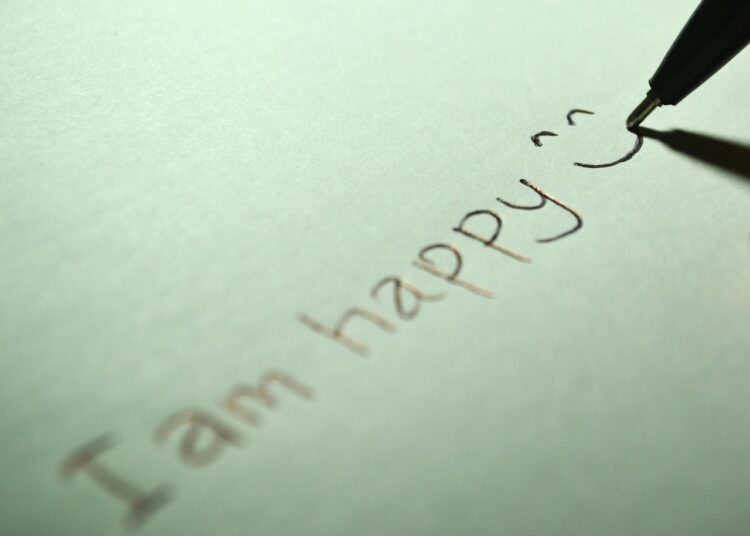
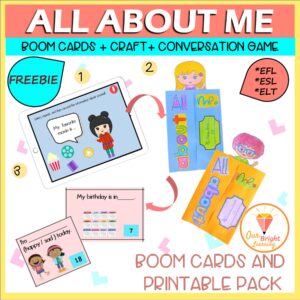
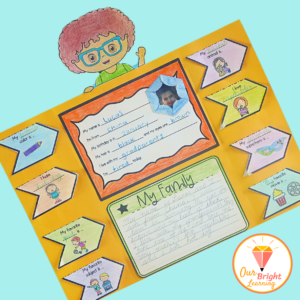
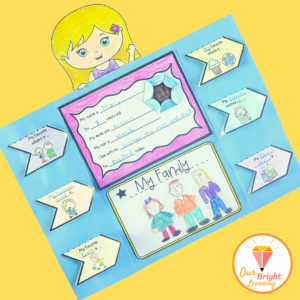



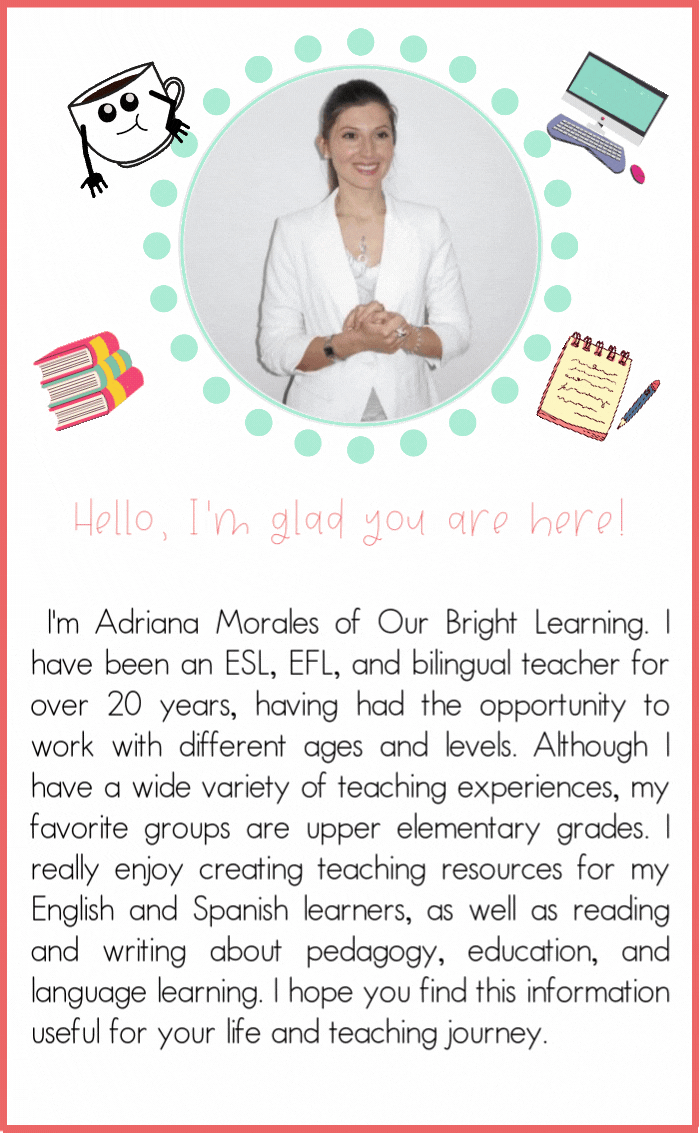
Discussion about this post